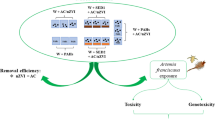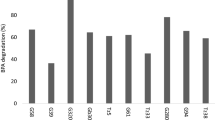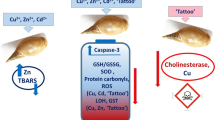Abstract
Cis-trans isomerization of unsaturated fatty acids is a crucial adaptive reaction of Pseudomonas and Vibrio species to toxic organic compounds or other environmental stress factors. In order to test the long-term performance of this adaptive mechanism as well as to assess its application as biomarker for environmental contamination studies were performed in batch cultures and in continuously running sand columns, simulating long-term contamination with bisphenol A (BPA). In short-term grown batch cultures a high correlation between trans/cis ratio and added BPA concentration and toxicity was observed. In contrary, this did not occur in the case of long-term sand columns. An increase in trans/cis ratio of unsaturated fatty acids only appeared in a limited period of time. Afterwards the trans/cis ratio reached the values measured for non-stressed cultures. Cis-trans isomerization is only an urgent response mechanism that is later substituted by other adaptive mechanisms. Therefore, it can be concluded that the trans/cis ratio of unsaturated fatty acids was shown not to be an appropriate biomarker for durable stress in the environment.





Similar content being viewed by others
References
Bettmann H, Rehm HJ (1984) Degradation of phenol by polymer entrapped microorganisms. Appl Microbiol Biotechnol 20:285–290
Bligh EG, Dyer WJ (1959) A rapid method of total lipid extraction and purification. Can J Biochem Physiol 37:911–917
Chen M-Y, Ike M, Fujita M (2002) Acute toxicity, mutagenicity, and estrogenicity of bisphenol A and other bisphenols. Environ Toxicol 17:80–86
de Bont JAM (1998) Solvent-tolerant bacteria in biocatalysis. Trends Biotechnol 16:493–499
Frostegard A, Baath E, Tunlid A (1993a) Shifts in the structure of soil microbial communities in limed forests as revealed by phospholipid fatty-acid analysis. Soil Biol Biochem 25:723–730
Frostegard A, Tunlid A, Baath E (1993b) Phospholipid fatty acid composition, biomass and activity of microbial communities from two soil types exposed to different heavy metals. Soil Biol Biochem 25:723–730
Gillan FT, Hogg RW (1984) A method for the estimation of bacterial biomass and community structure in mangrove-associated sediments. J Microbiol Methods 2:275–293
Grogan DW, Cronan JE Jr (1997) Cyclopropane ring formation in membrane lipids of bacteria. Microbiol Mol Biol Rev 61:429–441
Guckert JB, Antworth CP, Nichols PD, White SC (1985) Phospholipid, ester-linked fatty acid profiles as reproducibility assays for changes in prokaryotic community structure of estuarine sediments. FEMS Microbiol Ecol 31:147–158
Guckert JB, Hood MA, White DC (1986) Phospholipids ester-linked fatty acid profile changes during nutrient deprivation of Vibrio cholerae: increases in the trans/cis ratio and properties of cyclopropyl fatty acids. Appl Environ Microbiol 52:794–801
Ike M, Chen M-Y, Jin C-S, Fujita M (1995) Isolation and characterization of a novel bisphenol A-degrading bacterium Pseudomonas paucimobilis strain FJ-4. Jpn J Water Treatment Biol 31:203–212
Ike M, Chen M-Y, Jin C-S, Fujita M (2002) Acute toxicity, mutagenicity, and estrogenicity of biodegradation products of bisphenol A. Environ Toxicol 17:457–461
Isken S, de Bont JAM (1998) Bacteria tolerant to organic solvents. Extremophiles 2:229–238
Heipieper HJ, Diefenbach R, Keweloh H (1992) Conversion of cis unsaturated fatty acids to trans, a possible mechanism fort he protection of phenol-degrading Pseudomonas putida P8 from substrate toxicity. Appl Environ Microbiol 58:1847–1852
Heipieper HJ, Weber FJ, Sikkema J, Keweloh H, de Bond JAM (1994) Mechanism behind resistance of whole cells to toxic organic solvents. Trends Biotechnol 12:409–415
Heipieper HJ, Loffeld B, Keweloh H, de Bond JAM (1995) The cis/trans isomerization of unsaturated fatty acids in Pseudomonas putida S12 an indicator for environmental stress due to organic compounds. Chemosphere 30:1041–1051
Heipieper HJ, Meulenbeld G, van Oirschot Q, de Bont JAM (1996) Effect of environmental factors on the trans/cis ratio of unsaturated fatty acids in Pseudomonas putida S12. Appl Environ Microbiol 62:2773–2777
Heipieper HJ, Meinhardt F, Segura A (2003) The cis-trans isomerase of unsaturated fatty acids in Pseudomonas and Vibrio: biochemistry, molecular biology and physiological function of a unique stress adaptive mechanism. FEMS Microbiol Lett 229:1–7
Heipieper HJ, Neumann G, Cornelissen S, Meinhardt F (2007) Solvent-tolerant bacteria for biotransformations in two-phase fermentation systems. Appl Microbiol Biotechnol 74:961–973
Holtwick R, Meinhardt F, Keweloh H (1997) Cis-trans isomerization of unsaturated fatty acids: cloning and sequencing of the cti gene from Pseudomonas putida P8. Appl Environ Microbiol 63:4292–4297
Kabelitz N, Machackova J, Imfeld G, Brennerova M, Pieper DH, Heipieper HJ, Junca H (2009) Enhancement of the microbial community biomass and diversity during air sparging bioremediation of a Northern Bohemia soil highly contaminated with kerosene and BTEX. Appl Microbiol Biotechnol 82:565–577
Kaur A, Chaudhary A, Kaur A, Choudhary R, Kaushik R (2005) Phospholipid fatty acid-A bioindicator of environment monitoring and assessment in soil ecosystem. Curr Sci 89:1103–1112
Keweloh H, Heipieper HJ, Rehm HJ (1989) Protection of bacteria against toxicity of phenol by immobilization in calcium alginate. Appl Microbiol Biotechnol 31:383–389
Kharlamenko VI, Imbs AB, Tarasov VG (2009) Physiological state of microbial communities and mats of the bottom sediments in the marine shallow-water hydrothermal ecosystem of Kraternaya Bight (Kurile Islands). Russian J Marine Biol 35:323–330
Kiran MD, Annapoorni S, Suzuki I, Murata N, Shivaji S (2005) Cis-trans isomerase gene in psychrophilic Pseudomonas syringae is constitutively expressed during growth and under conditions of temperature and solvent stress. Extremophiles 9:117–125
Li YL, Peacock AD, White DC, Geyer R, Zhang CLL (2007) Spatial patterns of bacterial signature biomarkers in marine sediments of the Gulf of Mexico. Chem Geol 238:168–179
Lobos JH, Leib TK, Su T-M (1992) Biodegradation of bisphenol A and other bisphenols by a Gram-negative aerobic bacterium. Appl Environ Microbiol 58:1823–1831
Loffeld B, Keweloh H (1996) Cis/trans isomerization of unsaturated fatty acids as a possible control mechanism of membrane fluidity in Pseudomonas putida P8. Lipids 31:811–815
MacNaughton SJ, Stephen JR, Venosa AD, Davis GA, Chang YJ, White DC (1999) Microbial population changes during bioremediation of an experimental oil spill. Appl Environ Microbiol 65:3566–3574
Morrison WR, Smith LM (1964) Preparation of fatty acid methyl esters and dimethylacetals from lipids with boron fluoride-methanol. J Lipid Res 5:600–608
Navarrete A, Peacock A, Macnaughton SJ, Urmeneta J, Mas-Castella J, White DC, Guerrero R (2000) Physiological status and community composition of microbial mats of the Ebro Delta, Spain, by signature lipid biomarkers. Microb Ecol 39:92–99
Pepi M, Heipieper HJ, Fischer J, Ruta M, Volterrani M, Focardi SE (2008) Membrane fatty acids adaptive profile in the simultaneous presence of arsenic and toluene in Bacillus sp ORAs2 and Pseudomonas sp ORAs5 strains. Extremophiles 12:343–349
Perry GJ, Volkman JK, Johns RB (1979) Fatty acids of bacterial origin in contemporary marine sediments. Geochem Cosmochem Acta 43:1715–1725
Pinkart HC, White DC (1997) Phospholipid biosynthesis and solvent tolerance in Pseudomonas putida strains. J Bacteriol 179:4219–4226
Spivack J, Leib TK, Lobos JH (1994) Novel pathway for bacterial metabolism of bisphenol A Rearrangements and stilbene cleavage in bisphenol A metabolism. J Biol Chem 269:7323–7329
Ramos JL, Duque E, Rodorigues-Herva JJ, Godoy P, Haïdour A, Reyes F, Fernandez-Barrero A (1997) Mechanisms for solvent tolerance in bacteria. J Biol Chem 272:3887–3890
Ramos JL, Gallegos MT, Marques S, Ramos-Gonzales MI, Espinosa-Urgel M, Segura A (2001) Responses of Gram-negative bacteria to certain environmental stressors. Cur Opin Microbiol 4:166–171
Ramos JL, Duque E, Gallegos MT, Godoy P, Ramos-Gonzales MI, Rojas AT, Teran WM, Segura A (2002) Mechanisms of solvent tolerance in Gram-negative bacteria. Annu Rev Microbiol 56:743–768
Ronen Z, Abeliovich A (2000) Anaerobic-aerobic process for microbial degradation of tetrabromobisphenol A. Appl Environ Microbiol 66:2372–2377
Sasaki M, Maki J, Oshiman K, Matsumura S, Tsuchido T (2005) Biodegradation of bisphenol a by cells and cell lysate from Sphingomonas sp strain AO1. Biodegradation 16:449–459
Sikkema J, de Bont JA, Poolman B (1995) Mechanisms of membrane toxicity of hydrocarbons. Microbiol Rev 59:201–222
Staples CA, Dorn PB, Klečka GM, O'Block ST, Harris LR (1998) A review of the environmental fate, effects, and exposures of bisphenol A. Chemosphere 36:2149–2173
Staples CA, Woodburn K, Caspers N, Tilghman Hall A, Klečka (2002) A weight of evidence approach to aquatic hazard assessment of bisphenol A. Hum Ecol Risk Asses 8(5):1083–1105
Volkman JK, Johns RB (1977) The geochemical significance of position isomers of unsaturated acids from intertidal zone sediments. Nature 267:693–694
von Wallbrunn A, Richnow HH, Neumann G, Meinhardt F, Heipieper HJ (2003) Mechanism of cis-trans isomerization of unsaturated fatty acids in Pseudomonas putida. J Bacteriol 185:1730–1733
Weber FJ, Isken S, de Bont JAM (1994) Cis/trans isomerization of fatty acids as a defense mechanism of Pseudomonas putida strains to toxic concentrations of toluene. Microbiology 140:2013–2017
White DC, Stair JO, Ringelberg DB (1996) Quantitative comparisons of in situ microbial biodiversity by signature biomarker analysis. J Ind Microbiol 17:185–196
Zhang Y, Rock CO (2008) Membrane lipid homeostasis in bacteria. Nature Rev Microbiol 6:222–233
Acknowledgments
This work was partially supported by Contracts No. 003998 and 211684 of the European Commission within their Sixth and Seventh Framework Program projects BIOTOOL and BACSIN, respectively.
Author information
Authors and Affiliations
Corresponding author
Rights and permissions
About this article
Cite this article
Fischer, J., Schauer, F. & Heipieper, H.J. The trans/cis ratio of unsaturated fatty acids is not applicable as biomarker for environmental stress in case of long-term contaminated habitats. Appl Microbiol Biotechnol 87, 365–371 (2010). https://doi.org/10.1007/s00253-010-2544-0
Received:
Revised:
Accepted:
Published:
Issue Date:
DOI: https://doi.org/10.1007/s00253-010-2544-0




